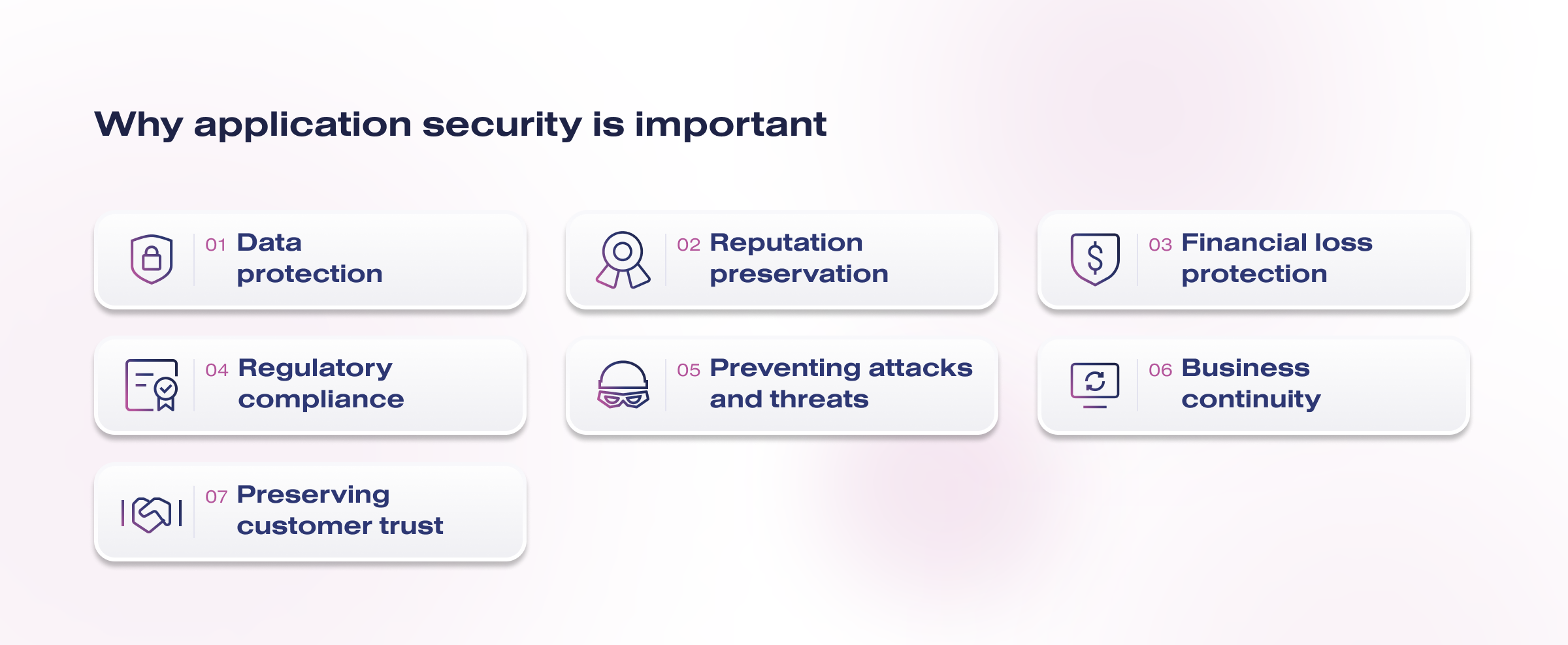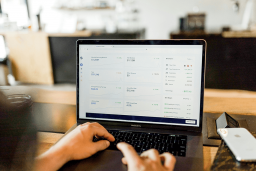The number of mobile applications in the world is snowballing. About 100,000 new apps appear in Google Play every month. According to Statista, as of the first quarter of 2022, 3.48 million Android apps were available in Google Play. In comparison, the App Store offered 2.22 million iOS apps. The number of users of these products is multiplying.
According to Oberlo, in 2016, mobile traffic in the world exceeded web traffic and has grown by 58% since then. Most banks, stores, and airline companies have applications. Mobile access to goods and services has long been commonplace. However, the number of new vulnerabilities found in mobile applications has increased by 300% since 2017.
This article discusses why application security is important, the most common software weaknesses, and types of application security testing.
Key points
What is application security?

When we talk about app security, we primarily refer to identifying, analyzing, and managing risks embedded in the app development cycle. It encompasses technologies and practices that reduce the likelihood of stolen passwords, sensitive data, hacking, and application disruption.
Continuous app vulnerability analysis is critical to information security because it allows companies to find and fix flaws while apps are still developing before release.
Ideally, security analysis combines manual penetration testing and automated analysis during the development cycle. This approach provides the greatest coverage of possible application vulnerabilities.
Why application security is important

The popularity of mobile and web applications and their penetration into the processes of companies provoke the growth of cybersecurity threats. Hackers are increasingly launching attacks to steal personal data and transaction information or disrupt the operation of applications.
Developers often write insecure code to build products quickly and attract users, creating vulnerabilities and jeopardizing their company and its customers. Cyberattacks can be very costly to businesses, especially financial ones like banks developing mobile banking apps. They lead to direct financial losses, damage a company’s reputation, and provoke regulatory fines and customer churn.
So, application security is of utmost importance for the following reasons:
- Data protection. Many apps handle sensitive and personal user data such as financial data, medical information, personal correspondence, and more. Inadequate security can lead to data breaches, which can cause serious damage to both users and organizations.
- Reputation preservation. Data leaks or successful attacks on an application can seriously damage an organization’s reputation. Loss of user trust can lead to a decline in customers and revenue.
- Financial loss protection. Successful attacks can result in financial losses from data breaches, fines for violating data protection laws, and the cost of recovering from the incident.
- Regulatory compliance. Many countries have laws and regulations that require organizations to comply with data security standards and notify customer leaks. Failure to comply with these requirements can result in legal consequences.
- Preventing attacks and threats. Application security not only protects against current threats but also prevents future attacks. By actively strengthening security, vulnerabilities can be detected and addressed before attackers exploit them.
- Business continuity. Protected applications can continue to operate even after a security incident, such as a denial of service (DDoS) or other attack. This helps ensure business continuity.
- Preserving customer trust. Users expect their data to be protected when using applications. Ensuring application security helps in maintaining customer and user trust.
Consequently, application security is integral to the success of modern organizations and applications and directly impacts reputation, financial stability, and law-abidingness.
Most common software weaknesses

Companies use fairly advanced tools and practices to test their web applications for security. However, everything is limited to periodic manual checks regarding mobile software. This situation is due to a lack of quality tools for security analysis and a shortage of competencies.
Mobile software differs significantly from web applications and is potentially more vulnerable. Unlike web apps, which run in an isolated browser, mobile applications run on a device connected to a cloud server. They interact directly with the OS and other applications and store system information on the device.
Mobile solutions provide hackers with a wide range of attack opportunities. Today, almost 1/3 of applications contain such vulnerabilities as storing information in an insecure location, insecure information transfer, insecure authorization, and security issues in open-source libraries.
Insufficient data encryption
One of the most common vulnerabilities is insufficient or incorrect data encryption. Developers often do not pay enough attention to this aspect. It can lead to the possibility of sensitive information being intercepted and disclosed. To address this vulnerability, developers should use strong encryption algorithms such as AES (Advanced Encryption Standard) and properly manage encryption keys.
Insecure data storage
Another common vulnerability is insecure data storage on a user’s device. Suppose, an application stores sensitive information, such as passwords or payment card data, unencrypted or in vulnerable storage. In that case, an attacker can access that data. To address this vulnerability, developers should utilize secure storage mechanisms such as Keychain (iOS) or Keystore (Android) that provide encryption and secure storage.
Insecure handling of user input
Vulnerabilities related to insecure user input processing can lead to injection or cross-site scripting (XSS) attacks. Suppose, an application does not properly validate and filter user input. In that case, an attacker can inject malicious code or perform unwanted operations on a user’s device. To address this vulnerability, developers must properly validate and filter user input using appropriate techniques such as data sanitization and SQL query preparation.
Improper authentication and authorization
Improper authentication and authorization is a serious vulnerability. It can lead to unauthorized access to an application or its functions. For example, weak passwords, lack of an account lockout mechanism after several failed login attempts, or improper authorization checks can enable an attacker to gain full control of a user’s account. To address this vulnerability, developers should implement strong authentication mechanisms, such as two-factor authentication. They also should properly manage and verify user access rights.
Malicious libraries and third-party components
Often, mobile app developers use third-party libraries and components to speed up the development process. However, if these libraries contain vulnerabilities or malicious code, they can become a security risk. Developers should regularly update the libraries they use to the latest versions and watch for new vulnerabilities.
Lack of protection against reverse engineering
Lack of protection against reverse engineering can lead to the disclosure of algorithms and application logic. Attackers can use it to create malicious application variants or unauthorized access to the server infrastructure. To address this vulnerability, developers can use code obfuscation techniques, encryption, and dynamic code loading to make reverse engineering more difficult.
Unprotected network requests
Suppose, an application transmits or receives data through unprotected network requests. In that case, it becomes vulnerable to man-in-the-middle or code injection attacks. Developers should use encryption protocols like HTTPS to secure network requests. They also should validate server certificates to prevent attacks using forged certificates.
Insufficient security testing
Insufficient security testing is one of the major causes of vulnerabilities in mobile apps. Developers should conduct thorough security testing of the app. This includes testing for vulnerabilities, hacking, and attack scenarios. Automated security testing tools can help identify and fix vulnerabilities in an app.
What is application security testing?

Application security testing is a process of evaluating and assessing the security of a software application to identify vulnerabilities, weaknesses, or potential threats that malicious actors could exploit. The primary goal of application security testing is to ensure that an application is robust and resilient against security risks, thereby protecting sensitive data and maintaining the trust of users and stakeholders.
The IT industry has developed approaches to mobile application security – MAST (mobile application security testing) practices. They have become a solution to many application security problems.
Types of application security testing
There are four key types of application security testing:
- SAST is a static application security testing. It detects insecure configurations. It looks for tokens, encryption keys, and other confidential data, checks the correctness of network communication configuration, etc. It is a static analysis of the application source code.
- DAST is a dynamic application security testing. It identifies insecure network traffic and entry points that third-party applications can trigger.
- API ST is an API security testing. It analyzes forwarded messages between the application and its server for sensitive information.
- IAST is an interactive application security testing. It monitors application data flows and tracks data movement from entry points to potentially dangerous functions.
Regular use of MAST practices for security analysis will help ensure maximum coverage of mobile application vulnerabilities.
In addition to MAST practices, the industry has adopted security standards such as OWASP Mobile Top 10, PCI DSS, CWE/SANS Top 25, etc. Checking compliance with these standards helps avoid basic security errors in application development.
How can SoloWay Tech help you secure your application?

Our team has been developing applications and improving their security for over 15 years. We have witnessed all the transformation paths of mobile and web apps and coped with dozens of diverse pitfalls. Here is how the SoloWay Tech team can assist you:
- Threat assessment. We can perform a thorough threat assessment to identify potential vulnerabilities and risks associated with your mobile application.
- Secure coding practices. By ordering custom mobile app development at SoloWayTech, you can be sure of it’s highest security. Our developers follow secure coding practices to minimize common vulnerabilities like SQL injection, cross-site scripting (XSS), and more.
- Regular testing. Our team can conduct regular security testing, such as penetration testing and code reviews, to identify and fix vulnerabilities in your mobile app.
- Security updates. With our help, you can stay up-to-date with security patches and updates for all software components used in your application.
- Regular maintenance. Our team can continuously monitor and maintain the security of your mobile application even after deployment.
Remember that security is an ongoing process. A reputable software development company like SoloWay Tech should be committed to helping you maintain the security of your application throughout its lifecycle.
Conclusion
Ensuring the security of mobile applications is an important task for developers. Understanding key vulnerabilities and applying appropriate prevention techniques can help mitigate risks and protect user data. 5 basic principles to help improve the security of your company’s mobile ecosystem:
- Regular automated analysis of mobile applications for vulnerabilities following MAST practices. This can be accomplished using specialized solutions that allow you to build automated checks into your DevOps.
- Regular testing of mobile applications for compliance with security standards OWASP4, OWASP Mobile Top 10, PCI DSS, CWE/SANS Top 25.
- Periodic penetration tests for manual external verification of programs.
- Regular audits of released mobile applications to identify newly described vulnerabilities, including those in third-party components.
- Development of team competencies to create secure code at the earliest stages of mobile application development. Special training programs for developers are focused on this.
Security is becoming increasingly important and challenging. Developers must be prepared to deal with various vulnerabilities that can jeopardize the confidentiality and integrity of user data. Want to check the security of your application? Contact SoloWay Tech right now!




